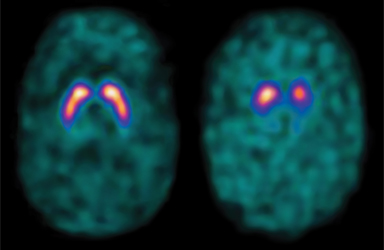DaTscan™ Imaging
DaTscan provides detailed images of dopamine activity within the brain, which helps us differentiate between various Parkinsonian syndromes as well as between Parkinson’s disease and essential tremor—diseases that often share similar symptoms.
Saint Luke’s Marion Bloch Neuroscience Institute offers DaTscan Spectroscopy, the first FDA-approved scan for neurodegenerative movement disorders.
Parkinson’s disease is difficult to diagnose, especially at its onset. Patients often present with atypical history or symptoms. Other medical conditions can further complicate the process. The scan helps prevent misdiagnosis and provides patients with disease-specific treatment options.
How DaTscan works
DaTscan uses a radioactive drug which highlights the activity of dopamine transporters (DaT) in the brain. A patient receives an injection of DaTscan tracer. The exam uses SPECT imaging (single photon emission computed tomography) to track how the tracer collects within the brain.
DaTscan results
DaTscan is ordered only when a neurologist already suspects a Parkinsonian syndrome or essential tremor. It is not a diagnostic test by itself.
- Normal DaTscan (left image) shows two symmetric comma- or crescent-shaped regions in the middle of the brain. For a patient with tremor, this finding often leads to an essential tremor diagnosis.
- Abnormal DaTscan (right image) may include any of the following characteristics: left/right asymmetry, more circular or oval shapes, or faint dopamine activity. An abnormal DaTscan indicates a deficiency of dopamine—a sign of Parkinson’s disease or other primary Parkinsonian syndromes.
